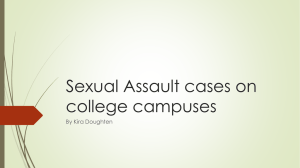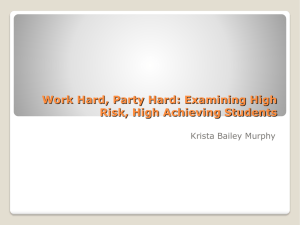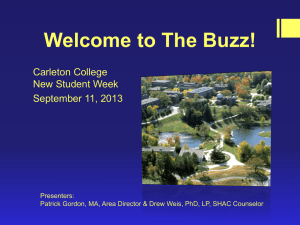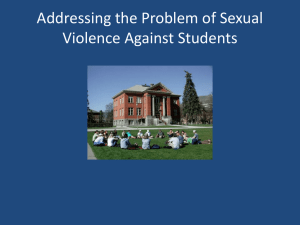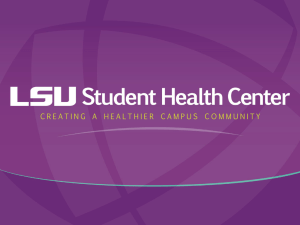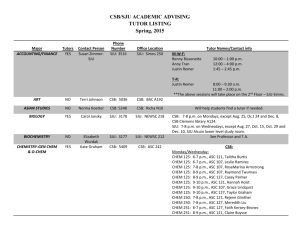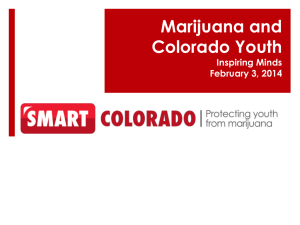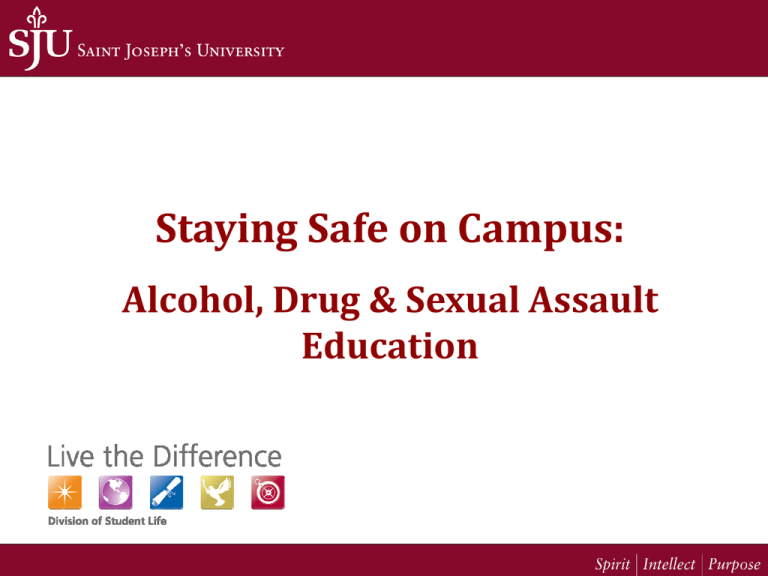
Staying Safe on Campus:
Alcohol, Drug & Sexual Assault
Education
Objectives
• Alcohol Education/Harm
Reduction
• Assessment of Use
• Alcohol & the Body
• Blood Alcohol Level
• Marijuana and Other Drugs
• Sexual Assault & Personal
Safety
• SJU Policies and Resources
Part I: Why more alcohol
education?
• SJU supports a “harm reduction” approach to college drinking
and alcohol education.
• The optimal outcome of harm reduction is abstinence however,
harm reduction approaches acknowledge that any steps to
reduce risk is a step in the right direction.
• Remember - Harm Reduction is aimed at keeping students safe,
should they choose to use alcohol. However, the illegal use of
alcohol, especially the high risk use of alcohol, may lead to
negative consequences, including intervention and accountability
by SJU or the police.
What is your role
today?
Please participate and
be honest!
Regarding alcohol… if
you do not currently
drink….
• Great!
• The info that we cover
may be helpful for a
friend
What is our role
today?
To help students make
informed decisions
about alcohol use.
To engage in a
conversation around the
serious consequences
of all types of drug use.
To discuss issues
around personal safety
on and off campus.
Part II: Assessment Alcohol of Use
Drinking is a science.
so……
What is in a standard
drink?
**Orientation Leaders will demonstrate using an
activity
A standard drink is 1/2 ounces of
ethyl alcohol…
• That translates to….
•
•
•
•
•
•
•
12 oz of beer
10 oz of microbrew or wine cooler
8 oz of malt liquor or ice beer
4 oz of wine
1.25 oz of 80 proof liquor
1 oz of 100 proof liquor
1 can of 4 Loko = 5.6 standard drinks because it
contains 2.88 ounces of pure ethanol
How many ounces are in a red
solo cup?
a.
b.
c.
d.
e.
3-4 ounces
5-7 ounces
9-12 ounces
16-18 ounces
No idea
Think back….
• To an occasion when you drank
the most during the past year….
(If you do not drink, what about an
amount you watched someone drink?)
1. How many standard drinks did
you/ they have?
2. Did behavior change based on
an increased number of
standard drinks?
3. Did consequences increase?
How much does the “average” SJU
student drink?
In a survey of SJU first-year students from
August, 2010
• 82.2% said that they had used alcohol, at least once, in
the past year
• 17.8% identified as non-drinkers
• The average number of drinks per week in a typical week,
as identified by SJU students, is 7.3 standard drinks per
week.
Data collected using MyStudentBody, 2010
Why are typical behaviors and
average behaviors distorted?
Part III: Alcohol Expectancies
Drinking can be fun…
• What kind of positive things do you associate with
drinking?
• How many drinks does it take to experience these
positive effects?
• How many drinks until the positive aspects turn to
negative consequences?
Until…..
What are some of the
not so fun things
about drinking?
Consequences of Alcohol
• Vandalism
• Violence and Sexual Assault
(Alcohol is the #1 date rape
drug)
• Arguments/broken
relationships
• Impaired Academic Work
• Injury
• Trouble with police, University
• Loss of respect… becoming
“THAT Person.”
Part IV: Alcohol 101
• What is alcohol?
• “Depressant” is often misused - basically alcohol
slows down the Central Nervous System
• Because our brain is part of the CNS, we see
deficits in how our brain functions (motor
coordination & cognitive processing)
How does alcohol get into your
system?
Absorption
•
•
•
Swallow drink
Into stomach
20% through your stomach
and into blood stream
The rest of the alcohol enters your
small intestine & enters your
bloodstream rapidly
What influences the rate of
absorption?
(how quickly alcohol enters bloodstream)
• The higher the concentration of alcohol
in your drink.
• The faster you drink, the faster the
alcohol enters your bloodstream
• Too much + too fast = high risk use &
negative consequences
Part V: Blood Alcohol Level
• BAL = BAC = Blood
Alcohol Level/Content
• Ratio of alcohol to blood
in bloodstream
• Pennsylvania Legal Limit
• Over 21 = .08
• Under 21 = .02
(you can get a DUI with a .02)
• BAC is not # of drinks
Alcohol’s Effects & BAC
•
•
•
•
•
•
•
•
.02 - .04 - Lightheaded
.05 - .07 - Buzzed
.08 - .10 - Legally impaired
.11 - .15 - Drunk
.16 - .19 - Very Drunk/ brown outs & black outs
.20 - .24 - Dazed & confused/ black outs
.25 - .30 - stupor
.31 and higher - coma or death
Tips for Moderate Drinking
•
•
•
•
•
•
•
•
•
Set your limits before you go out
Keep track of how much you drink
Space your drinks
Alternate alcoholic & non-alcoholic drinks
Drink for quality, not quantity
Avoid drinking games
It is okay to refuse a drink
Find other things to do!
If you chose to drink, do so slowly and in a
safe environment
• Avoid taking shots
• Avoid drinks that mix alcohol & caffeine
(Redbull & vodka, 4Loko, etc.)
Myth-busters
1.
All people are created equal when it comes to how alcohol impacts the
body?
FALSE (Quantity, Rate, Weight, Times, & Gender all make a difference)
2.
With a BAC of .08, how long will it take to “sober up” to a BAC of .00?
5 hours (.08%….064%….048%….032%….016%….00%)
TIME is the only way to sober up. Alcohol leaves the body at a rate of
.016%... No matter what you do!
3. “ High Tolerance” means that you can drink more, and obtain a lower BAC than
someone with a lower tolerance.
FALSE – Tolerance is actually a need for greater consumption to get the same
effects. Two people of the same weight and gender who have been drinking
the same amount at the same rate will reach the same BAC levels, even if one
has developed tolerance and the other hasn’t.
4. Is Marijuana considered a Depressant or a Stimulant?
Marijuana has characteristics of both. As a stimulant, it can increase heart
rate, impact Blood Pressure and weaken the heart. It can mask the effects of
alcohol, making for a dangerous combination.
Part VI: Marijuana & Other Drugs
• Monitoring the Future Study (High School Seniors 2009)
35% of students report past year use of drugs
• Marijuana
• 32% report past year use
• Any illicit drug other than marijuana
• 15% report past year use
• Vicodin, Narcotics other than heroine.
• Amphetamines, hallucinogens, tranquilizers
“Prescription” Drug Use
• College student illegal use of Xanax, Adderall,
Ritalin, & Concerta is on the rise nationally
• “Researchers noted that despite the perceptions
of the students, there is no real evidence that
non-medical use of prescription stimulants helps
students perform better academically, noting that
the non-medical use of prescription stimulants is
often indication of problem behaviors among
college students.” - Community Anti-Drug Coalitions of America
Information gathered from NIDA
• SJU University Policy – can be found
responsible for violating the University Drug
Policy if you are using others’ Rx drugs, or even
abusing your own Rx.
Community Standards at SJU
(click here for video)
Part VII:
SJU Safety Information
Alcohol & Sexual Assault
More than 75% of acquaintance rapes involve alcohol
use by the victim or perpetrator.
•
•
•
•
•
Watch out for friends and vice versa- leave bars or parties
together. If a friend is acting out of character or appears
intoxicated, help him/her.
Don’t drink from punch bowls or large open containers.
Pour your own drinks, don’t accept drinks from others.
Trust your instincts- if you do not feel safe, get help.
If someone is under the influence of Alcohol, they can
not consent to sex.
Sexual assault is a crime of motive & opportunity.
Ultimately there is no surefire way to prevent an
attack. If you think you have been assaulted, there
are services to help you at SJU.
Understanding Sexual Victimization
• Sexual assault is a traumatic experience for
anyone.
• It can happen anywhere & to anyone.
• Sexual assault is a crime of violence. It is
never about love or affection- it is about
power & control.
• Victims of sexual assault may feel violated
and powerless.
Risk Reduction
Response to Sexual Assault
Sexual assault is a crime of motive & opportunity.
Ultimately there is no surefire way to prevent an attack
and it is never the victim’s fault.
Find someone you know & trust to support you.
You need to be in control of the response.
Get medical assistance
Decide whether or not to report the assault to police
and to SJU (they are there to help.)
Counseling & Support at SJU
How to Help a Friend
• Always believe a victim and reaffirm that
it is not their fault
• Try and offer a safe environment
• Do not blame the victim
• Do not push the victim to make quick
decisions. Let them decide in a pace in
which they want to talk about the
experience
• Be patient and supportive
Consent
Consent is not present if:
• A person says NO (in any way) & at any
point.
• A person is unable to give consent to sexual
contact because of disability, age, or the
influence of drugs, alcohol or medication;
asleep or unconscious.
•Just because consensual sex may have
occurred once, does not mean that sexual
assault can not occur in the future
Remember…
• Alcohol consumption is a
complicated issue
• Whether or not to drink is your
choice
• Weigh the risks and benefits
associated with drinking to make an
informed decision
• Respect the community, University
& surrounding area, where you will
spend the next 4 years
• Know the resources on Campus
Resources for Students
Office of Student Outreach & Support
WADE- Wellness, Alcohol & Drug Education Program
Campion 212
• Support for student’s during difficult personal situations
• Alcohol & Drug Assessment, in-person & on-line
• NA & AA meeting locations
Student Health Center, Sourin Hall, 1st Floor
Counseling & Psychological Services (CAPS)
Merion Gardens A504
• Free & confidential appointments
• Walk-in Center in LaFarge Hall/ 11:30-1:00 Mon-Fri
REPP (Rape Education & Prevention Program)
610-733-9650 (Student-run sexual assault 24 hour crisis hotline)
Office of Public Safety & Security
610-660-1111
Mystudentbody.com
You will receive an email
instructing you to complete the
alcohol, wellness and sexual
violence section of
mystudentbody.com before you
arrive on-campus.
All First-Year Students are
expected to complete this 60
minute, on-line course
Thank you!
Questions or Comments?
We look forward to
seeing you in the Fall!


